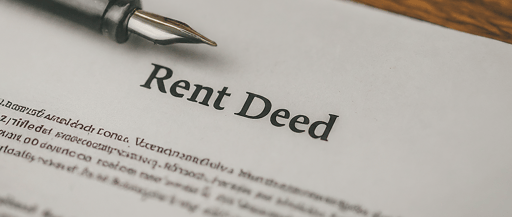"Daftese Consulting Private Limited"
Rent or Lease Agreement
About Rent/Lease Agreement
LEGAL DOCUMENTATION FOR INDIVIDUAL, ORGANISATION, NGO, REAL ESTATE COMPANY, BANK, FINANCIAL INSTITUTION, MORTGAGE COMPANY.
12/1/20246 min read


Rent/Lease Agreement deeds
A Rent/Lease Agreement is a legal contract between a landlord (lessor) and a tenant (lessee) outlining the terms and conditions under which the tenant can occupy the property for a specific period in exchange for rent. The terms of the agreement ensure the rights and obligations of both parties are clear and enforceable in case of disputes. It is critical for both residential and commercial leases.
Here are the detailed aspects of Rent/Lease Agreement Deeds:
1. Types of Rent/Lease Agreements:
Rent Agreement (Less Than 12 Months): Typically used for shorter rental periods (often 11 months). Rent agreements for 11 months are commonly used to avoid the complexities of rent control laws.
Lease Agreement (12 Months or More): A lease agreement is for a longer, fixed duration (usually a year or more). It is more detailed and provides long-term stability for both the landlord and tenant.
2. Key Clauses in Rent/Lease Agreements:
A standard rent/lease agreement must include the following essential clauses to ensure clarity:
Names of Parties: The full legal names of the landlord (lessor) and tenant (lessee).
Description of the Property: Detailed description of the property being rented, including address, size, and boundaries.
Duration/Term of the Lease: The start and end dates of the tenancy. For a rent agreement, this is usually 11 months, while for a lease agreement, it could be 12 months or more.
Rent and Security Deposit:
Rent: The monthly rent amount, payment due date, mode of payment (bank transfer, cheque, cash, etc.).
Security Deposit: A refundable security deposit paid by the tenant at the beginning of the tenancy, usually amounting to 1-6 months’ rent. The conditions for refunding the security deposit should also be stated.
Rent Escalation Clause: For lease agreements, a clause that outlines the percentage by which rent will increase at the end of the lease term (typically 5%-10% yearly).
Maintenance and Repairs: Defines who is responsible for routine maintenance and repairs. Usually, the tenant handles minor repairs, while the landlord handles major repairs.
Utility Bills and Other Charges: Clarifies which party is responsible for paying utility bills like water, electricity, gas, and maintenance charges for common areas (for apartments).
Termination Clause: Specifies the notice period required for early termination of the agreement by either party, usually one to three months. It also outlines the conditions under which either party can terminate the agreement (e.g., breach of terms).
Use of Property: States that the tenant should use the property for residential purposes only (in case of a residential lease) or for the specific commercial activity stated (in a commercial lease).
Subletting Clause: Specifies whether the tenant is allowed to sublet the property to another party and under what conditions.
Renewal Clause: Details how the agreement can be renewed upon expiration and whether any rent increase will apply at renewal.
Lock-in Period: In some leases, there is a "lock-in period" during which neither party can terminate the agreement.
Eviction Clause: Conditions under which the landlord can evict the tenant (e.g., non-payment of rent, misuse of the property).
Penalty for Late Payment: Any penalties or interest applicable if the rent is paid late.
3. Registration of Rent/Lease Agreements:
In India, registration of the agreement is mandatory if the rental period is more than 11 months. Here’s the process for rent/lease deed registration:
Step 1: Draft the Agreement: The landlord and tenant must draft a written agreement outlining all the terms. This document must be clear and legally sound to avoid disputes.
Step 2: Stamp Paper: The agreement must be printed on stamp paper of the appropriate value, which varies depending on the state and the amount of rent or lease.
The stamp duty is usually a percentage of the annual rent plus the security deposit, and it varies by state. For example, in Maharashtra, stamp duty is 0.25% of the total rent and deposit.
Step 3: Signing of the Agreement: Both parties (landlord and tenant) must sign the agreement in the presence of two witnesses.
Step 4: Visit the Sub-Registrar’s Office: Both the landlord and tenant must visit the local sub-registrar’s office to register the rent/lease agreement. In some states, online registration of rent agreements is also available.
Step 5: Document Verification: Submit all necessary documents, including ID proofs of the parties, passport-sized photographs, and address proof of the property.
Step 6: Registration and Collection: Once the registration is complete, the registered document is returned, and it becomes legally enforceable.
Unregistered Rent/Lease Agreements:
If an agreement for more than 11 months is not registered, it is not enforceable in court. If disputes arise, such an agreement will not be accepted as legal evidence in case of a legal dispute between the landlord and tenant.
4. Documents Required for Registration:
Proof of Identity: Aadhaar card, passport, voter ID, or PAN card of both landlord and tenant.
Property Documents: Ownership documents of the property (title deed or tax receipts).
Proof of Residence: Address proof for both parties (utility bills, rental receipts, etc.).
Photographs: Passport-sized photographs of the landlord, tenant, and witnesses.
Proof of Stamp Duty Payment: Receipt showing the stamp duty has been paid.
5. Key Legal Aspects of Rent/Lease Agreements:
Rent Control Laws: In India, many states have rent control laws that regulate the amount of rent that can be charged and protect tenants from unfair evictions. These laws differ from state to state and generally apply only to leases for more than 12 months.
Security Deposit Limit: In some states, there are laws regulating the amount of security deposit a landlord can charge. For instance, in Karnataka, the security deposit is capped at two months’ rent for residential leases.
Tenant’s Rights: Tenants have the right to live in the property undisturbed for the duration of the agreement, provided they abide by the terms of the lease. They also have the right to receive a refund of the security deposit upon vacating the property, minus any deductions for repairs or unpaid dues.
Landlord’s Rights: Landlords have the right to timely rent payments and to repossess the property at the end of the lease term or if the tenant breaches the agreement. They also have the right to deduct repair costs or unpaid rent from the security deposit.
6. Termination of Rent/Lease Agreement:
By Mutual Agreement: The agreement can be terminated if both parties mutually agree, often with a notice period of one to three months.
For Breach of Agreement: Either party can terminate the agreement if the other party violates any of the terms (e.g., non-payment of rent, subletting without permission, or illegal activities on the property).
Notice Period: The agreement usually specifies a notice period (typically 30-90 days) that either party must provide if they wish to terminate the agreement early.
7. Commercial vs. Residential Lease:
Residential Lease: Typically simpler, focuses on residential usage of the property. Tenants cannot use the property for commercial purposes.
Commercial Lease: More complex, often includes clauses related to the specific type of business, alterations to the property, and a longer lock-in period. Commercial leases also often include terms for common area maintenance (CAM) charges, insurance requirements, and zoning laws.
8. Online Rent Agreement Registration:
In many states, the registration of rent/lease agreements can now be done online through government portals. This allows the landlord and tenant to fill out the necessary forms, upload documents, and pay stamp duty and registration fees online. However, for physical signatures, either party may still need to visit the sub-registrar’s office, unless e-signature is accepted.
9. Advantages of Registering Rent/Lease Agreements:
Legal Validity: A registered agreement is admissible in court and can be used in case of disputes between the landlord and tenant.
Protects Rights: Both parties’ rights and obligations are clearly defined and legally enforceable.
Transparency: Registration ensures that the rental/lease process is transparent and helps in avoiding future conflicts over rent, security deposits, or property use.
10. Common Pitfalls to Avoid:
Unregistered Agreement: Not registering the agreement when the term is 12 months or more can render it legally unenforceable.
Ambiguous Clauses: Ensure that all terms are clearly stated and there is no ambiguity, especially regarding rent escalation, security deposit, and termination.
Inadequate Maintenance Clauses: Clarify which party is responsible for which repairs and maintenance to avoid disputes later on.
Overcharging for Utilities: Clearly state which utilities the tenant is responsible for, and ensure fair practices in charging for them.
Summary:
Rent/lease agreements are crucial for defining the terms of property occupation between a landlord and tenant. They must include clear clauses related to rent, security deposits, maintenance, and termination, among others. Proper registration ensures that the agreement is legally enforceable, protecting the rights of both parties
For any quarry feel free to contact us at daftese.com


